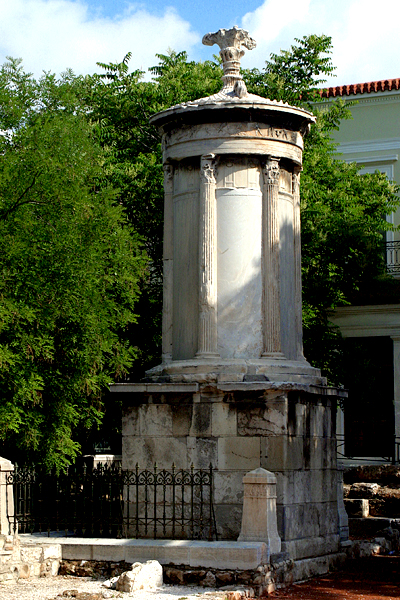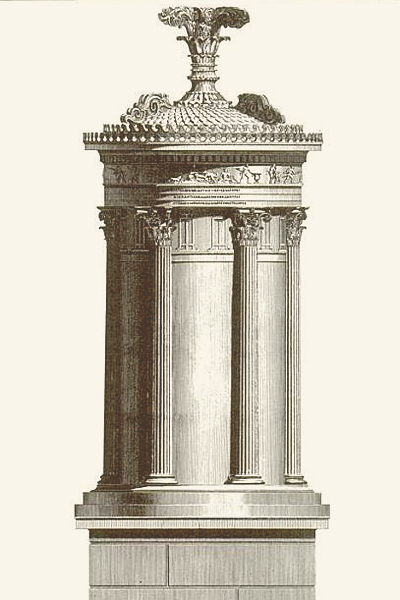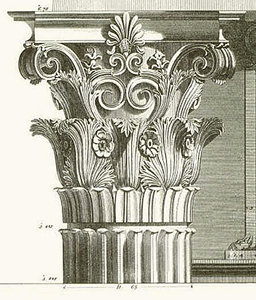
"The mountains look on Marathon—
And Marathon looks on the sea;
And musing there an hour alone,
I dream'd that Greece might yet be free
For, standing on the Persians' grave,
I could not deem myself a slave."
Lord Byron, The Isles of Greece (Don Juan, Canto LXXXVI)
Connecting the Agora with the Theater of Dionysus was the Street of the Tripods, which, relates Pausanias "takes its name from the shrines, large enough to hold the tripods which stand upon them, of bronze, but containing very remarkable works of art, including a Satyr, of which Praxiteles is said to have been very proud" (Description of Greece, I.20.1; Plutarch, Life of Aristides, who "left in the precinct of Dionysus as offerings for victory some choregic tripods, which, even in our day, were pointed out as still bearing the inscription: 'The tribe Antiochis was victorious; Aristides was Choregus; Archestratus was Poet,'" I.3).
These tripods were the prizes awarded to the choregos (leader of the chorus, who sponsored its training and outfitting) for victory in the dramatic contests of the Dionysia. Set up on rectangular bases, by the fourth century BC, they stood on elaborate pedestals, usually in the form of temples. The Monument of Lysicrates (335–334 BC) is the only surviving example of a choragic monument and originally was surmounted by a bronze tripod commemorating his sponsorship of the chorus that had won first prize. (That of Thrasyllus on the side of the Acropolis, which had been dedicated in 319 BC, was destroyed by the Ottoman Turks in 1826.)
Sitting on a square limestone podium, a course of three stairs form the base of a cylindrical tholos with six Corinthian columns of Pentelic marble at the joints of its curved walls. (Although the columns seem to be engaged, they actually are whole pillars joined by the panels.) Between the columns is a frieze of tripods carved in relief and, above them an architrave of three bands carrying a dedicatory inscription and a frieze depicting the adventure of Dionysus and the pirates whom he turned into dolphins (Homeric Hymn to Dionysus, VII; Ovid, Metamorphoses, III.572ff). The god sits, caressing a panther, with satyrs serving him wine while others, brandishing thyrses, torches, and clubs, drive the pirates into the sea, where they already are beginning to be transformed.
The cupola is a single block of marble carved to look like a pattern of laurel leaves. The tripod sat on top of an elaborate acanthus finial with three heavy floral scrolls at the base that may have supported bronze dolphins. The monument was purchased by the French from the Ottoman Turks and, in 1669, incorporated into a Capuchin monastery, where it was used as a library and reading room. Lord Byron, who fought for Greek independence and died there in 1824, once had stayed at the monastery, which was destroyed that year during the fighting. The monument, which was partially buried in the rubble, was restored by the French School of Archaeology in the nineteenth century.

The monument is the one of the very earliest examples of the Corinthian order, preceded almost a century before by the Temple of Apollo at Bassae, which Pausanias relates was built by Ictinus, the architect of the Parthenon (VIII.41.7-9). There, the Corinthian capital is used in the interior, whereas the Monument of Lysicrates is the first time the order appears on the exterior. It was not until the Augustan period, however, that the Corinthian emerged in its own right as the preeminent order in Rome.
The type favored by the Romans consisted of two rows, each formed of eight acanthus leaves. Between the leaves of the upper row were eight stalks (caulicoli) from which volutes emerged to support the angles of the abacus and a central foliated ornament, one on each face. Greek examples usually displayed these ornaments as a palmette (anthemion, "flower").

In the Monument of Lysicrates, the flutes of the shaft terminate in lotus leaves, above which a channel has been cut that may have held a bronze collar. There is a lower row of sixteen lotus leaves and an upper row of acanthus leaves, each separated by a petalled flower resembling a lotus. The volutes or helices support tall palmettes on each face.
The engravings are from The Antiquities of Athens (1762) by Stuart and Revett, who were the first to recognize the story of Dionysus and the pirates. Although meticulously drawn, there is an idealizing tendency, in which the masonry of the base is rendered as regular and even, when the courses actually are varied and irregular.
The interior apparently never was intended for use, as the capitals were left unfinished and there is no provision for any light. The podium, too, is not solid, as was discovered when Stuart and Revett actually broke through one side only to discover a small irregular core.)
References: Classical Architecture: An Introduction to Its Vocabulary and Essentials, with a Select Glossary of Terms (2003) by James Stevens Curl; The Antiquities of Athens: Measured and Delineated by James Stuart and Nicholas Revett, Painters and Architects (1762-1816/2007) edited by Frank Salmon.